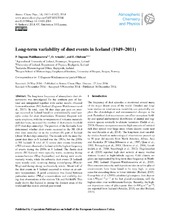Long-term variability of dust events in Iceland (1949-2011)
Peer reviewed, Journal article
Published version
Permanent lenke
https://hdl.handle.net/1956/10206Utgivelsesdato
2014-12-16Metadata
Vis full innførselSamlinger
- Geophysical Institute [1198]
Originalversjon
https://doi.org/10.5194/acp-14-13411-2014Sammendrag
The long-term frequency of atmospheric dust observations was investigated for the southern part of Iceland and interpreted together with earlier results obtained from northeastern (NE) Iceland (Dagsson-Waldhauserova et al., 2013). In total, over 34 dust days per year on average occurred in Iceland based on conventionally used synoptic codes for dust observations. However, frequent volcanic eruptions, with the re-suspension of volcanic materials and dust haze, increased the number of dust events fourfold (135 dust days annually). The position of the Icelandic Low determined whether dust events occurred in the NE (16.4 dust days annually) or in the southern (S) part of Iceland (about 18 dust days annually). The decade with the most frequent dust days in S Iceland was the 1960s, but the 2000s in NE Iceland. A total of 32 severe dust storms (visibility < 500 m) were observed in Iceland with the highest frequency of events during the 2000s in S Iceland. The Arctic dust events (NE Iceland) were typically warm, occurring during summer/autumn (May–September) and during mild southwesterly winds, while the subarctic dust events (S Iceland) were mainly cold, occurring during winter/spring (March–May) and during strong northeasterly winds. About half of the dust events in S Iceland occurred in winter or at sub-zero temperatures. A good correlation was found between particulate matter (PM10) concentrations and visibility during dust observations at the stations Vík and Stórhöfði. This study shows that Iceland is among the dustiest areas of the world and that dust is emitted year-round.
Utgiver
European Geosciences UnionCopernicus Publications

